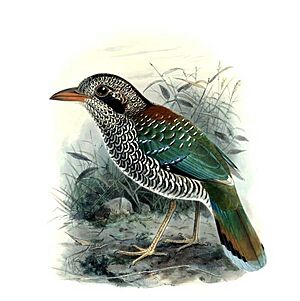Scaly ground roller facts for kids
Quick facts for kids Scaly ground roller |
|
|---|---|
 |
|
| Conservation status | |
| Scientific classification | |
| Genus: |
Geobiastes
|
| Species: |
squamiger
|
| Synonyms | |
The scaly ground roller (Geobiastes squamiger) is a special type of bird found only in eastern Madagascar. It's the only species in its group, which is part of the Brachypteraciidae bird family. These birds love to live in lowland rainforests where it's warm and wet. You can usually find them in areas below 1,000 m (3,300 ft) high. It's one of the few birds in Madagascar that stays in these low-lying forests.
Contents
What Does It Look Like?
Scaly ground rollers are medium-sized birds, growing to be about 27 to 31 cm (11 to 12 in) long. Their head has a cool black and white pattern that looks like scales. Their body is a pretty copper-brown color, and their wings are green with white tips. The middle of their tail is reddish-brown, ending with blue tips and black marks. The underside of their body is pale, with black crescent shapes. They have a thick, long gray beak and pink legs.
What Does It Eat?
The scaly ground roller mostly eats small creatures it finds on the ground. These are usually invertebrates, which are animals without backbones. But they also eat small vertebrates, which are animals with backbones.
- They often eat earthworms and centipedes.
- Sometimes, they also munch on spiders, frogs, and small lizards.
- They've even been seen eating tiny tenrecs, which are small mammals.
How It Raises Its Young
Scaly ground rollers build their nests in small burrows in the ground. These burrows are usually about 6.5 to 10 cm (2.6 to 3.9 in) wide and 55 to 77 cm (22 to 30 in) deep. They like to build their nests near water and in places with lots of plants covering the ground.
- The female bird lays her eggs from mid-October to early November.
- She usually lays only one egg at a time.
- The female sits on the egg for about 18 days to keep it warm until it hatches.
- While the female is on the nest, the male bird brings her food.
- Once the chick hatches, both parents work together to find food for their baby.
About Its Name

This bird has had a few different scientific names over the years. Scientists sometimes change names as they learn more about how species are related. Some of its older names include:
- Brachypteracias squamigera (given by Frédéric de Lafresnaye in 1838)
- Atelornis squamirgera (given by Jacques Pucheran in 1846)
- Geobiastes squamigerus (given by Gustav Hartlaub in 1877)
Until the 2000s, this bird was known as Brachypteracias squamigera. But then, scientists decided to move it to its own group, called Geobiastes. This was because they found out it wasn't as closely related to the other birds in the Brachypteracias group as they first thought. The name Geobiastes squamiger is now its official scientific name.
Where Did Its Name Come From?
The first part of its scientific name, Geobiastes, comes from two Ancient Greek words:
- gē means "ground"
- biastēs means "mighty" or "one who uses force"
The second part of its name, squamiger, comes from Latin words:
- squama means "scale"
- -gera means "carrying"
So, "scaly ground roller" makes sense because of its "scaly" head and its habit of finding food on the "ground"!
Is It in Danger?
The scaly ground roller is considered a vulnerable species by the IUCN. This means it's facing threats and could become endangered if things don't change.
- The biggest threat to this bird is habitat loss. This happens when its forest home is cut down or changed by people.
- Even though its home is shrinking, this bird is better at dealing with climate change and changes to the forest than some other similar birds.
- However, climate change could still cause more of its habitat to disappear in the future.
- Sometimes, human hunters and even pet dogs can also be a danger to these birds.


